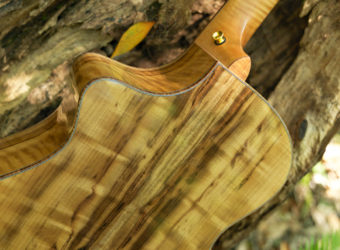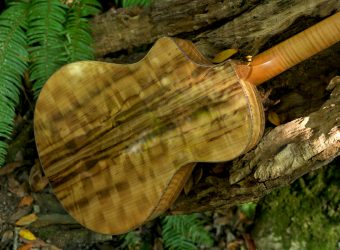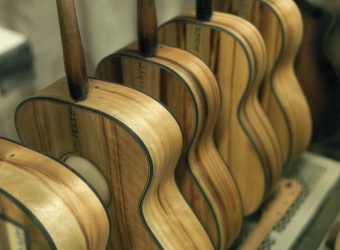 While many guitar players are seasoned pros when it comes to their craft, the world of tonewoods can still hold surprises. Myrtlewood, a relatively newer tonewood on the scene (even though it’s been in use for over 30+ years), might not be familiar to every guitarist, but its unique qualities are worth exploring. In this newcomer’s guide, we’ll delve into the basics of myrtlewood, offering insights into its origins, characteristics, and why it’s worth your attention as a discerning player.
While many guitar players are seasoned pros when it comes to their craft, the world of tonewoods can still hold surprises. Myrtlewood, a relatively newer tonewood on the scene (even though it’s been in use for over 30+ years), might not be familiar to every guitarist, but its unique qualities are worth exploring. In this newcomer’s guide, we’ll delve into the basics of myrtlewood, offering insights into its origins, characteristics, and why it’s worth your attention as a discerning player.
1. What is Myrtlewood?
Myrtlewood might be a newcomer to your vocabulary, but it’s a tonewood that’s making waves in the guitar world. Derived from the myrtle tree, native to the Pacific Northwest, myrtlewood boasts distinctive grain patterns and colors ranging from blondes to deep chocolates. Its sonic properties contribute to its appeal, offering a blend of warmth, clarity, and versatility that can enhance your playing experience.
2. Why Myrtlewood Matters for Guitars
As a guitarist with a discerning ear, you understand the importance of tonewoods in shaping the sound and character of your instrument. Myrtlewood has earned its place among guitar makers for several reasons. Its tonal balance, clarity, and responsiveness make it a valuable material for crafting acoustic guitars. Whether you’re recording in the studio or performing on stage, a myrtlewood guitar can deliver the sonic excellence you crave.
3. Getting to Know Myrtlewood Guitars
If you’re considering adding a myrtlewood guitar to your collection, you’re in for a treat. Breedlove has embraced myrtlewood across many guitar lines, showcasing its beauty and sonic prowess in many instruments. From the soundboard that resonates with each strum to the back and sides that provide depth and richness, a myrtlewood guitar offers a playing experience that’s both inspiring and rewarding.
4. Exploring Myrtlewood’s Sound
Curious about how a myrtlewood guitar sounds? Picture warmth and clarity combined with a balanced tonal profile that responds to your every touch. Whether you’re fingerpicking intricate melodies or strumming chords with gusto, a myrtlewood guitar can bring out the best in your playing. Its versatile sonic qualities make it suitable for a wide range of musical styles and genres, allowing you to express yourself with clarity and finesse.
5. Choosing a Myrtlewood Guitar
As a newcomer to myrtlewood, selecting the right guitar for your needs requires careful consideration. Think about factors such as your budget, preferred body style, and the sound you’re looking to achieve. Take the time to test out different instruments, paying attention to how they feel and sound in your hands. Whether you’re a seasoned player or a newcomer to the guitar world, finding the perfect myrtlewood guitar can be a rewarding journey.
6. Caring for Your Myrtlewood Guitar
Once you’ve chosen your myrtlewood guitar, it’s essential to care for it properly to ensure its longevity and performance. Simple maintenance tasks like regular cleaning, humidification, and proper storage can help preserve the beauty and playability of your instrument. Treat your myrtlewood guitar with care, and it will continue to inspire you for years to come.
From its origins in the Pacific Northwest to its influence on the sound of acoustic guitars, myrtlewood offers a unique blend of beauty and sonic excellence. Whether you’re a seasoned player seeking new horizons or a newcomer eager to explore the possibilities, a myrtlewood guitar can be your faithful companion on your musical journey. Embrace the magic of myrtlewood, and let your music soar to new heights. Happy playing!





